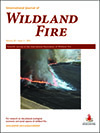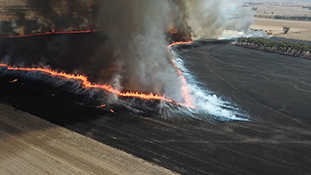
International Journal of Wildland Fire
Volume 30 Number 3 2021
Common measures of wildfire risk mitigation as the sum of activities ‘completed’ are problematic. Measuring mitigation as the proportion of relevant activities completed and allowing respondents to indicate the amount of work they have undertaken reveals more nuanced relationships between demographics and mitigation than the sum of activities completed.
WF19095 Abstract | WF19095 Full Text | WF19095PDF (159 KB) Open Access Article
Potential Wildfire Operational Delineations, or ‘PODs’, are a collaborative planning approach for proactively identifying locations where wildfires potentially could be contained. We found PODs may facilitate communication across actors and jurisdictions and consideration of a greater range of response options. Effective use of PODs will require dedicated leadership and capacity.
WF20096Effects of fuel spatial distribution on wildland fire behaviour
 , Rodman Linn, Alex Jonko
, Rodman Linn, Alex Jonko  , Chad Hoffman
, Chad Hoffman  , Jeffrey D. Hyman
, Jeffrey D. Hyman  , Francois Pimont
, Francois Pimont  , Carolyn Sieg and Richard S. Middleton
, Carolyn Sieg and Richard S. Middleton 
Ensembles of physics-based fire model simulations demonstrate that the fidelity and spatial heterogeneity of fuel influenced simulated fire behaviour. Increased variance of fuel density resulted in decreased fire behaviour metrics compared with a homogenous fuel representation. However, large forest gaps overcame the effect of increased variance of fuel density as fire behaviour metrics rebounded.
WF20015Spatial and temporal dynamics of live fuel moisture content in eastern Mediterranean woodlands are driven by an interaction between climate and community structure
We analysed how species composition and climate affect fuel moisture content in Mediterranean plant species. We found that, on average, high diversity decreases fuel moisture in wet sites, but increases fuel moisture in dry sites. As fuel moisture affects combustibility, our results suggest a link between species diversity and fire risk.
WF20088Quantifying merging fire behaviour phenomena using unmanned aerial vehicle technology

Merging fires can lead to rapid increases in fire intensity and spread rate. To better understand their behaviour, several field-scale experiments were conducted during April 2019 on harvested wheat fields in western Victoria, Australia. Quantitative analysis of fire behaviour of merging fire fronts and comparison with previous findings were performed.
WF20088 Abstract | WF20088 Full Text | WF20088PDF (1.3 MB) | WF20088Supplementary Material (33.9 MB) Open Access Article
Using rate of fire spread data from experiments in grass fuels, we comment on the simulation results obtained by Moinuddin et al. (2018). In contrast with these simulations results, available empirical data shows grass height to have a direct (positive) effect on rate of fire spread.
WF20091A response to comments of Cruz et al. on: ‘Simulation study of grass fire using a physics-based model: striving towards numerical rigour and the effect of grass height on the rate of spread'
We confirmed that two modes of fire propagation (wind-driven and plume-driven) exist as found in various empirical evidence, including CSIRO data. Many of the apparent discrepancies can be reconciled through the proper observance of the different parametric regimes that are represented in the various experimental and simulation results.



